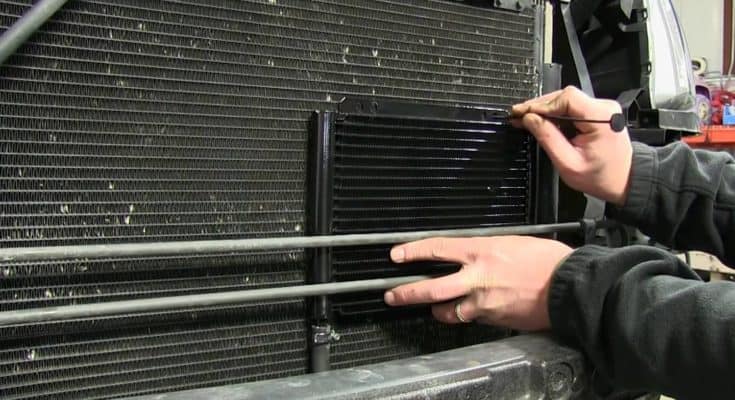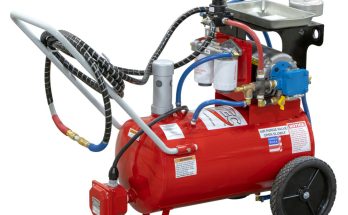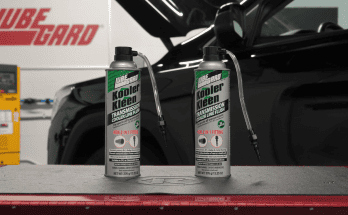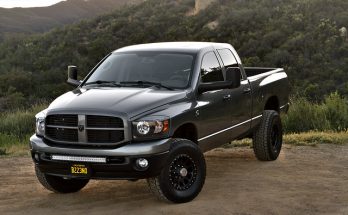Do I Need To Install A Transmission Cooler?
There are a number of benefits to using a transmission cooler on your car, truck, or SUV. The biggest benefit to installing an auxiliary transmission oil cooler is that it will help do what its name indicates, which is cool your transmission fluid.
No, you do not need to install a transmission cooler, but it helps lower transmission fluid better than the factory transmission cooler can.
More often than not, most vehicles can utilize a transmission cooler to help prolong the life of their transmission. There are different types of transmission coolers, and each one comes in different shapes, sizes, and has their own benefit.
Any type of transmission cooler you plan on installing will help reduce trans fluid temperatures. This keeps your transmission in a safe operating range which in turn will allow your transmission to last longer.
Before you decide to install a transmission cooler, be sure to figure out what transmission coolers might be best for your application, and let our easy to follow transmission cooler installation instructions help.
Transmission Cooler Mounting Position
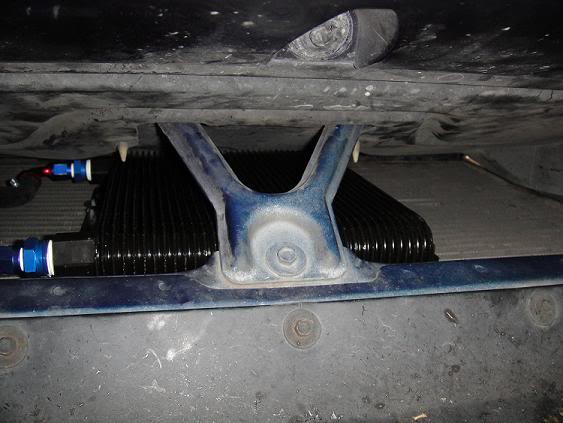
When figuring out how to install a transmission cooler, it is typically recommended to mount it in a location that gets a significant amount of airflow. Based on this, the best place to mount a cooler would be in front of the air conditioning condenser. This position will allow the trans cooler to get ample air flow while moving in addition to getting air from the engine’s cooling fans when stopped.
When installing a transmission cooler on the condenser, using a transmission oil cooler mounting kit will make the process easy and hassle free. The mounting kits come with heady duty plastic zip ties and rubber spacers. The spacers are used to space the cooler from the condenser to prevent direct contact between the two. You can find transmission mounting kits here.
In some applications however, it may be best to have a remote mounted transmission cooler that utilizes a fan to help cool the fluid. This is typically found in more extreme applications such as those who drag race or tow for example.
Where ever your cooler is mounted, it needs to get enough air flow to help keep the fluid cool.
Transmission Cooler Orientation
When installing automatic transmission coolers, there is often debate as to whether cooler orientation matters. More often than not, transmission cooler orientation does not make much of a difference. While some may argue that you need to install a certain type of cooler inverted to prevent air bubbles, the transmission line pressure it strong enough to push fluid through the entire cooler to prevent this.
Does It Matter Which Way A Transmission Cooler Is Mounted?
No, not really. You can mount a transmission cooler any way that makes installation and fluid flow easiest. Since the transmission fluid is pushed through the system with enough pressure, there is no need to worry about air pockets or bubbles causing issues unlike an engine’s cooling system.
Does A Transmission Cooler Go Before of After The Radiator?
Aftermarket transmission coolers are best installed after fluid has already gone through the radiator. Since hot fluid leaves the transmission then goes through the cooler inside the radiator, it makes sense to then route the transmission fluid that would go back to the transmission to the aftermarket cooler to further lower temperatures.
Can You Mount A Transmission Cooler Behind The Radiator?
It’s best to mount an external transmission cooler in front of the radiator or air conditioning condenser in order to get the most out of the installation. Since external transmission coolers rely on air flow going over their core to help lower transmission temperatures, it’s highly recommended to put it in a spot that’ll take advantage of getting as much air flow as possible.
Should I Bypass My Radiator When Installing An External Transmission Cooler?
A common question we get asked is whether it is recommended to bypass the radiator with your external transmission cooler. The easiest answer to this is, it depends. There are a number of factors that determine if you should use your trans cooler as a stand alone unit or in series with the factor radiator transmission cool.
If you live in a very warm area, it may be better to bypass the factory transmission cooler in the radiator in favor of a larger, external transmission cooler. Reason being, the radiator can act as a heater and warm the transmission fluid higher than where you may be comfortable with it operating (200 + degrees), especially if you face a lot of stop and go traffic or other harsh driving conditions.
It is recommended however to keep the factory radiator transmission cooler and use and external cooler if you live in a cooler climate. The factory cooler will help get the transmission temperature into a suitable range. When it comes to cooling your transmission, you can actually over cool it, and it may not be able to flow as well compared to warmer fluid.
Transmission Cooler Line Path & Flow Direction
When installing your new transmission cooler, it is important to figure out not only where you will mount it, but how to run the lines. In most applications where the external trans cooler is used in addition to the factory one, you will need to route the new transmission lines from the radiator to the external cooler.
The below transmission cooler installation diagram shows the transmission fluid flow direction and how the fluid will be routed through a new external cooler.
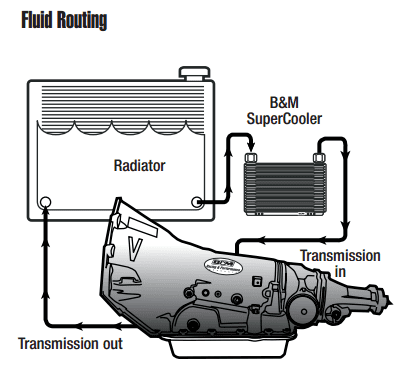
You will need to determine which line is the return for the transmission. You want the already warm fluid to flow into the external cooler to help better control fluid temperatures, so the transmission cooler flow direction will look something like this:
Transmission out (fluid hot) > radiator cooler in > radiator cooler out > external transmission cooler in > transmission cooler out > transmission in (fluid cool).
If you plan to use rubber transmission hose and keep the stock cooler lines, you need to connect the cooler return line to your vehicle’s return line. In most cases you’ll need to make a cut to the factory line and connect the new rubber line to it. This can be done with a double sided barb fitting, or by flaring the metal line and then clamping the new rubber hose to it.
How Much Does It Cost To Install A Transmission Cooler?
Aside from the purchase of a transmission cooler, additional costs may come from extra parts such as transmission fluid, transmission hose, clamps, fittings, and mounting pieces. A number of transmission coolers come with installation kits that contain most of these items aside from fluid. However, it is recommended to figure out what you need before buying a complete kit. Most transmission cooler installation kits may not be 100% complete for your application, so it would be best to assess what you need and what is included.
If you were to just purchase the cooler then source the additional parts needed, there would not be much of an additional cost.
If you have a desire to run custom lines and AN fittings, then the cost will certainly increase. While installing basic rubber lines might work for most, in some cases, your vehicle may need custom lines, which are more costly than standard transmission lines.
Depending on the cooler you purchase and your lines, you can spend as little as $20 extra to install a cooler, or in some cases, as much as $150 or more. Ultimately, the cost to install an automatic transmission oil cooler is dependent on what your needs are.
What Things Should I Consider When Installing A Transmission Cooler?
When installing a transmission cooler in your car, truck or SUV, it is important to consider not only the cooler size, but where to mount it, and how to run the lines. Mounting a transmission cooler is typically best in front of the air conditioning condenser so it gets ample air flow. Mounting here provides significant air flow which will help keep temperatures low.
In addition, having the right parts to install a transmission makes the process easier. Many trans coolers come with installation kits that contain rubber hose, clamps, fittings, and mounting hardware. While this is great, it is best to remember that these are universal kits that may not contain exactly what you need. When you install your cooler you will need to account for adding additional transmission fluid to compensate for the increased capacity of the transmission cooling system.
An automatic transmission cooler will not only help keep your fluid temperatures lower, but improves the longevity of your transmission. For a small investment, you can save thousands in repairs needed for replacing a failed transmission due to over heating.
- Provides quick, effective installation of Hayden products
- For installation of transmission coolers and electric fans
- Kit contains nylon mounting rods foam pads and locking buttons
- Package Dimensions: 22.86 L x 2.54 H x 5.08 W (centimeters)

